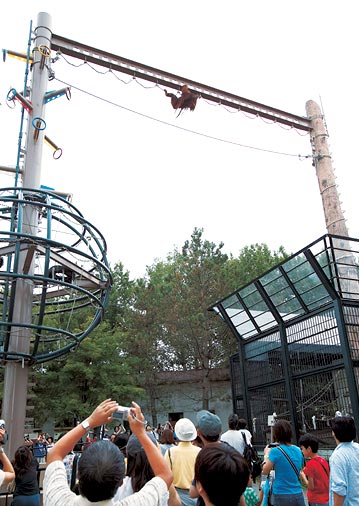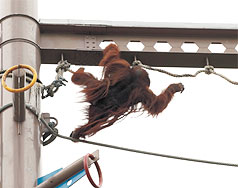Japan's Northernmost Zoo a Big Hit
Wildlife show times: Bringing out the true nature of the performers
The animals impress visitors with their lively, natural behavior, and are obviously happy in their surroundings, thanks to a number of innovations introduced by the zoo.
Take, for example, the Penguin Aquarium, home to four types of penguins, including the marching king penguins. They plunge deep into their large pool and swim this way and that, making a show for visitors walking through an underwater glass tunnel that runs the width of the pool (see this photo). The penguins dart about so quickly under the water that it is hard to imagine these are the same ones that shuffled about a while ago on the snow.
The Seal Aquarium is another great place to see water animals in action. It has a water-filled vertical tube (diameter, 1.5 meters) called the Marine Way, connecting a large upper pool with a lower one. Seals pass each other going in opposite directions, and sometimes stop to look at the people looking at them. It seems that they find us equally interesting. Why, you might think, would the seals take the trouble of passing through a narrow tube, instead of simply splashing about in one of the big pools? Actually, though, seals are in their element swimming straight up and down, and obviously enjoy doing so.
The unusual design of the wildlife showplaces is one key to the zoo's success. Another is the way the showplaces are used. The daily scheduled feeding times, called mogumogu taimu (munch time), are planned to bring out the extraordinary abilities of the animals.
Munch time at the Orangutan Plaza is a very popular event called the Sky Walk. An orangutan is at one tall pole, and his feeder, Hatakeyama Jun, talks to the crowd and puts food for him at the bottom of the other pole. The orangutan's challenge is to climb the pole above him, cross to the other pole along a steel girder and cable system 17 meters right above everyone, then climb down for his reward. He gets across easily, although the people below look worried, both for him and for themselves — there is no safety net, and they are directly below.
"A male orangutan can support a weight of 500 kg with his hands and arms, and we've never had a fall. The only problem is, once they get up high they tend to urinate, so you'll want to watch out if you're directly below, "Hatakeyama grins.
Munch time takes on different dimensions, depending on the place and animal. At the popular Polar Bear Aquatic Park, the bears dive into the pool for their food. Humans watch from behind glass.
 |
 |
Orangutan doing his Sky Walk, 17 meters above zoo visitors. He does the "walk" only from the end of April to mid-October, because orangutans find Hokkaido's winters too cold to want to go outdoors. |
